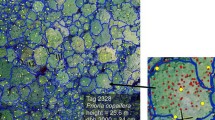Abstract
The correlation between foliage-canopy structure and vertical woody species distribution was examined in seven climax forests ranging from alpine tree limit to tropical rain forest. Foliage density was measured by two-dimensional canopy tomography using photographs.
Both foliage density and the vertical species density (the number of woody species having a maximum height within a vertical 1 m) were high in the upper canopy of warm-temperate and subtropical forests, but they were high at lower stratums in the tropical rain forest. Two variables correlated significantly despite the differences in foliage-canopy structures. In contrast to evergreen broad-leaved forests, a clear correlation could not be detected in northern cool-temperate and sub-alpine forests.
A possible reason for species convergence in the foliage dense stratum is that species with maximum height in that stratum may be able to survive in the stratum due to symmetrical crown-to-crown interaction. If the maximum height of dwarf species is less than the foliage dense stratum, it may be difficult to survive in the community. The lack of correlation in northern forests may be due to poor canopy tree flora and a mixture of different life forms (non-sprouting trees and sprouting shrubs).
Similar content being viewed by others
References
Asano, T. 1983. Regeneration process of beech forests. D.Sc. Thesis, Faculty of Science, Osaka City University (in Japanese).
Ashton, P.S. 1978. Crown characteristics of tropical trees. Tropical trees as living systems.In P.B. Tomlinson and M.H. Zimmermann eds., Cambridge University Press, Cambridge, pp. 591–615.
Gaudet, C.L. andKeddy, P.A. 1989. Comparative approach to predicting competitive ability from plant traits. Nature334: 242–243.
Hallé, F., Oldeman, R.A.A. andTomlinson, P.B. 1978. Tropical Trees and Forests. Springer-Verlag, Berlin.
Hollinger, D.Y., Kelliher, F.M., Shoulze, E.-D. andKostner, B.M.M. 1994. Coupling of tree transpiration to atmospheric turbulence. Nature371: 60–62.
Hotta, M., Ogino, K., Wakatsuki, T., Okada, H., Rusjdi, T. andArbain, A. 1984. List of plot tree 1. Pinang Pinang plot.In Forest Ecology and Flora of G. Gadut West Sumatra. Sumatra Nature Study (Botany), Kyoto, pp. 125–140.
Hotta, M., Suzuki, E., Kohyama, T., Koike, F. and Mukhtar E. 1989. Tentative Final Report of Research on a Decade Dynamics of Equatorial Forest System in Sumatra.
Kohyama, T. 1992. Size-structured multi-species model of rain forest trees. Functional Ecology6: 206–212.
Koike, F. 1985. Reconstruction of tree and forest canopy profiles using photographs. J. Appl. Ecol.22: 921–929.
Koike, F. 1986. Canopy dynamics estimated from shoot morphology in an evergreen broad-leaved forest. Oecologia70: 348–350.
Koike, F. 1989. Foliage crown development and interaction inQuercus guilva andQ. acuta. J. Ecol.77: 92–111.
Koike, F. 1994. Structure and light environment in the forest canopy of Lambir Hills National Park, Sarawak.In T. Inoue and A.A. Hamid eds., Plant Reproduction Systems and Animal Seasonal Dynamics. Center for Ecological Research, Kyoto University, Ohtsu.
Koike, F. andSyahbuddin 1993. Canopy structure of a tropical rain forest and its nature of unstratified upper canopy. Functional Ecology7: 230–235.
Koike, F., Tabata, H. andMalla, S. B. 1990. Canopy structure and its effect on shoot growth and flowering in subalpine forests. Vegetatio86: 101–113.
MacArthur, H. H. andHorn, H. S. 1969. Foliage profile by vertical measurements. Ecology50: 802–804.
Morita, Y. and Tagawa, H. 1981. Small scale succession in canopy gaps ofMachilus thunbergii forest.In S. Kuroiwa ed., Ecological Studies on Process and Mechanism of Forest Regeneration, pp. 47–54 (in Japanese).
Ohsawa, M. 1990. An interpretation of latitudinal patterns of forest limits in south and east Asian mountains. J. Ecol.78: 326–339.
Okubo, A. andLevin, S. A. 1989. A theoretical framework for data analysis of wind dispersal of seeds and pollen. Ecology70: 329–338.
Oldeman, A.A. 1978. Architecture and energy exchange of dicotyledonous trees in the forest.In P.B. Tomlinson M.H. Zimmermann eds., Tropical Trees as Living Systems. Cambridge University Press, Cambridge, pp. 535–560.
Popma, J., Bongers, F. andMeave del Castillo, J. 1988. Patterns in the vertical structure of the tropical lowland rain forest of Los Tuxtlas, Mexico. Vegetatio74: 81–91.
Tilman, D. 1988. Plant Strategies and the Dynamics and Structure of Plant Communities. Princeton University Press, Princeton.
Yamanaka, N. andTamai, S. 1986. On the population structure of shrubs in a natural beech forest of Kyoto University forest in Ashiu. Bulletin of the Kyoto University Forests57: 26–36 (in Japanese).
Author information
Authors and Affiliations
Rights and permissions
About this article
Cite this article
Koike, F., Hotta, M. Foliage-canopy structure and height distribution of woody species in climax forests. J. Plant Res. 109, 53–60 (1996). https://doi.org/10.1007/BF02344287
Received:
Accepted:
Issue Date:
DOI: https://doi.org/10.1007/BF02344287




